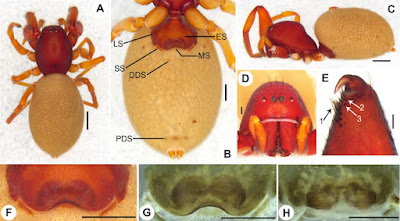 |
| Steriphopus wangala Kadam, Tripathi & Sankaran, in Sankaran, Tripathi et Kadam, 2024. |
Steriphopus Simon, 1887 is a poorly studied palpimanid genus, currently includes four nominal species distributed in India, Myanmar, Seychelles and Sri Lanka (WSC 2024). Zonstein & Marusik (2023) reviewed and rediagnosed the genus, and recorded it from India for the first time, with the description of a new species from Himachal Pradesh. Simon (1893) described Sarascelis raffrayi based on a single male specimen collected from Singapore. Until now, this species was known from a single taxonomic entry with only textual description that is insufficient to identify it (Simon 1893). In this paper, we describe a new species of Steriphopus from the northeastern part of India, and transfer S. raffrayi to Sceliraptor Zonstein & Marusik, 2022, based on photographs taken from the holotype.
....
Steriphopus wangala Kadam, Tripathi & Sankaran sp. nov.
Etymology. The specific epithet is a noun in apposition, referring to the harvest festival known as ‘the 100 drums festival’ among the Garo community of Meghalaya. This festival is held in honour of Saljong, the Sun-God of fertility, marking the end of a period of toil, and indicating the beginning of the winter season.
Pradeep M. Sankaran, Rishikesh Tripathi, Gautam Kadam. 2024. A New Species of Steriphopus Simon, 1887 from India (Araneae: Palpimanidae, Chediminae), with the proposal of a new combination. Zootaxa. 5474(1); 97-100. DOI: 10.11646/zootaxa.5474.1.10
